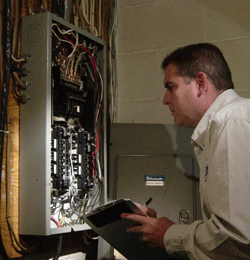One of the most crucial components of a home is its electrical system, which may pose some safety hazards if not properly maintained.
Service Disconnect Inspection
After locating the main disconnect, main service panel and sub-panels that may be present, America's Home Inspections will remove the covers very carefully and evaluate the interior components for the following items:
- Check for signs of corrosion on both the panel and all the interior connections. Corrosion on the interior of the panel may indicate water penetration via the service entrance cable or condensation problem areas.
- Look for circuit breakers/fuses that have more than one electrical conductor attached to them. Double or triple tapping is normally prohibited, by local jurisdictional requirements.
- Neutral wires should be properly secured to the neutral wire base. Check wires for signs of arcing, charred metal, or burnt wire insulation.
- There must be either a single means of disconnecting the electrical service system, or there must be no more than six disconnects in order to shut down the entire electrical system. (Six finger pulls or hand throws) Modern systems will have a single means; older split buss panels may have six disconnects.
- Adequacy of the electrical service should be determined. By today's standards, 100-amp service is considered minimal service.
- Identify the materials used for branch circuit wiring inside the service panel. Copper is preferred wiring material for all circuits 30 amps and under.
- Check the circuit breakers that are not properly secured or are loose. Some circuit breakers are not compatible with the box they are installed in, and some of the older Federal Pacific panels had this problem with the prescribed breakers. In these cases, the panel cover may be holding some of the breakers in place. Arcing is common with this situation, but it may not be readily visible until the insecure breaker is removed.
- Check the outside of the panel to see if it is warm or hot. This should be a cause for immediate concern.



